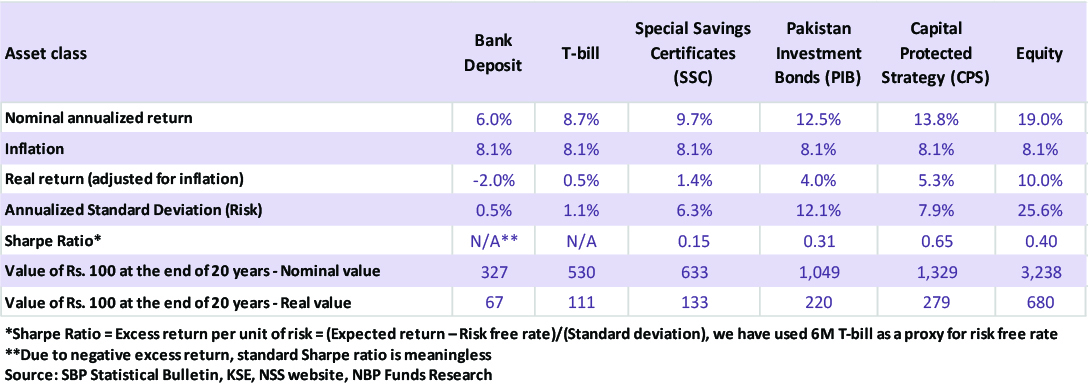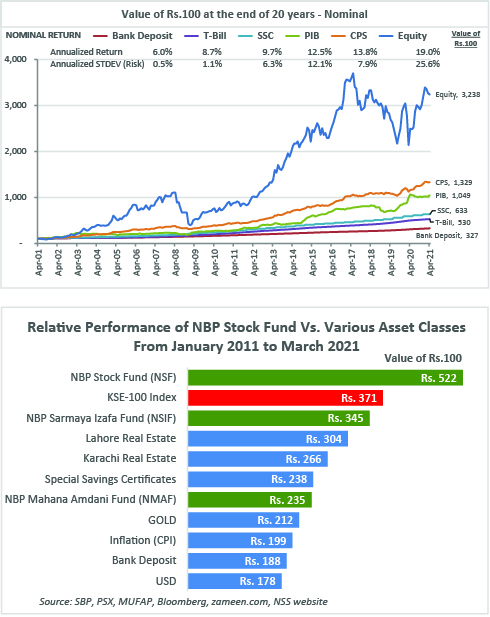The last four years have been challenging for the stock market investors. This subdued performance of the stock market has come after eight consecutive years of robust returns during which the KSE-100 Index surged by around 585%. Looking at the long-term performance of the stock market, it is evident that such periods with depressed returns do not stay forever. In the long run, stocks have outperformed all other asset classes, although it is volatile in the short-term. Historical market data cannot predict the future but it is still a useful guide to understand the potential risks and rewards for investors. With that in mind, we examine past performance of key domestic asset classes for a 20-year period from May 2001 to April 2021. We have included six asset categories for which long-term data is available: Treasury Bills, Bank Deposits, National Savings Schemes (NSS), Pakistan Investment Bonds (PIBs), Capital Protected Strategy (CPS), and Stocks. CPS is a synthetic asset class under which portfolio is dynamically managed between the low risk and high risk components with the aim of capital preservation, while also capturing some upside of the stock market. The results of the CPS are based on back-testing as this strategy was not in practice during this entire period. Inflation, as measured by CPI, has averaged 8.1% per annum and Pak Rupee has depreciated against the US Dollar by 4.7% per year, over the last twenty years.
The historical analysis, as given in the Table below depicts that stocks offered the highest nominal and real return amongst all asset classes. An investment of PKR 100 in stocks in May 2001 would be worth PKR 3,238 by the end of April 2021. During the same period, PKR 100 investment in bank deposits and T-Bills would have increased to a paltry PKR 327 and PKR 530, respectively.

The outcome of the above analysis supports the basic notion that there is a positive relationship between risk and return, meaning higher the risk the higher the return. In line with the expectation, stocks exhibited the highest volatility, and bank deposits and T-Bills have the lowest risk. The analysis also shows that over a long investment horizon, stocks delivered the highest return.
One take away from this analysis is that investors with long-term goals like educating their children, owning a house, or saving for retirement should have some of their assets invested in stocks, preferably through stock mutual funds, while investors with low-risk appetite due to short term investment needs, should invest in bank deposit or as an alternative in money market / income funds.
Well managed stock mutual funds have provided better returns to their investors than the stock market and other asset classes including real estate over the last ten (10) years period. For performance comparison, we have used the index provided by Zameen.com for the performance of real estate sector. As a case in point, our flagship stock fund, NBP Stock Fund (NSF) has out-performed the stock market by 151% over the last 10 years (from January 2011 till March 2021) by earning a return of 422% versus 271% rise in the stock market. An investment of Rs. 100 in NBP Stock Fund 10 years ago would have grown to Rs. 522 today, whereas an investment of Rs. 100 in the stock market (KSE-100 Index) 10 years ago would be worth Rs. 371 today. This out-performance of the Fund is net of management fee, and all other expenses.

Looking ahead, we hold a positive view on the stock market driven by improving economic outlook, attractive stock market valuations, easier monetary conditions, comfortable external account position, and promising corporate earnings prospects. From the fundamental perspective, the stock market is trading at an attractive Price-to-Earnings (P/E) multiple of 6.3x versus the long-term average of 8.4x. On relative valuation, 15.9% Earnings Yield offered by the stock market looks appealing compared with 10% yield on 10-years PIBs. Corporate earnings, the dominant driver of the stock market are expected to grow at double-digit rate over the next two to three years, based on our estimate. We expect the SBP to maintain the prevailing accommodative monetary policy stance with a modest 50-100 bps increase in the Policy Rate in CY21. Taken together, the market is well poised to deliver healthy double digit returns in CY21, and beyond. Therefore, we advise investors with medium to long-term investment horizon to build positions in stocks through our NBP stock funds, which have a superior performance track record.
Disclaimer: This publication is for informational purpose only and nothing herein should be construed as a solicitation, recommendation or an offer to buy or sell the fund. All investments in mutual funds and pension funds are subject to market risks. The price of units may go up as well as down. Past Performance is not necessarily indicative of future results. NBP Funds or any of its sales representative cannot guarantee preservation / protection of capital and / or expected returns / profit on investments.